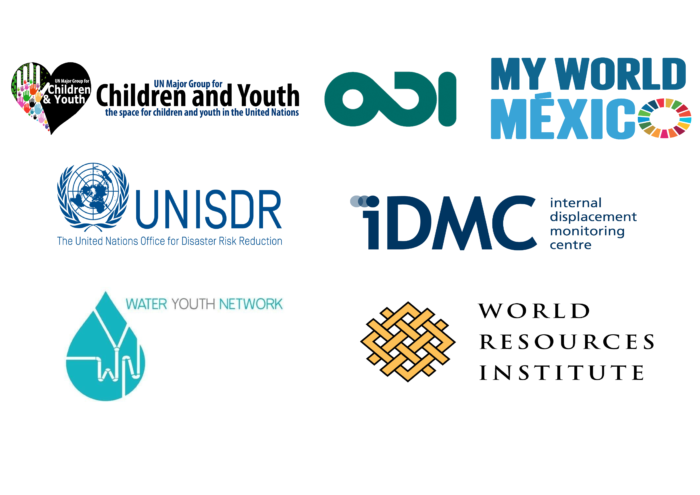Event Summary
Organization: UN Major Group for Children and Youth (UN MGCY), United Nations International Strategy on Disaster Risk (UNISDR), Overseas Development Institute (ODI), Water Youth Network (WYN), My World Mexico, World Resource Institute (WRI), Internal Displacement Monitoring Center (IDMC)
Speakers
- Rhea Katsanakis, United Nations Office for Disaster Risk Reduction (UNISDR)
- Katie Peters,Overseas Development Institute (ODI)
- Jail Cruz, My World Mexico
- Samantha Kuzma, World Resource Institute (WRI)
- Justin Ginnetti, Internal Displacement Monitoring Center (IDMC)
- Gabriela Guimarães Nobre (moderator), United Nations Major Group for Children and Youth (UNMGCY)
- Robert Sakic Trogrlic (moderator), Water Youth Network (WYN)
Description
Date: Tuesday, May 15, 2:oopm – 3:30pm
Room: Auditorio Bernardo Quintana
Migration and human displacement are history’s oldest and recurring human response to changing environments, either from social, environmental, or economic pressures. In the near future, the world’s growing population will be exposed to more frequent extreme weather, and the scale of humans flows, both internal and cross-border, temporarily or permanently, is expected to rise. Concurrently, interrelated factors are inducing migration, including economic and human rights inequalities, violence related to war, environmental change and destruction due to anthropogenic causes, and failure of governance. Such migration is often wrongfully perceived as a failure to adapt with rapidly changing and increasingly uncertain systems, rather than as a tool for relocation and coping mechanism in an effort to maintain dignity and freedom of opportunity; a fundamental element of the complex socio-environmental nexus. Just as disasters from hazards may drive migration, the mass incoming and outgoing movement of people may also significantly affect areas where these migrants originate from, transit to, as well as in their final destinations. Migration, climate change and social stability are key components of the 2030 Sustainable Development Agenda, and this complex nexus needs to be addressed in a holistic and innovative manner.
Objectives
This side event will (un)reveal both environmental and socioeconomic factors involved within the migration and human displacement cycles, with the aim of qualitatively mapping the dynamic nature of vulnerability, exposure and resilience, and their consequences on risk-related sustainable development targets. It will also discuss on how migration and human displacement are addressed by the Sendai Framework for Disaster Risk Reduction 2015–2030 (SFDRR) and across other relevant frameworks (e.g. Addis Ababa Action Agenda, New Urban Agenda, Paris Climate Change Agreement, and Global compact for safe, orderly and regular migration – amongst others). It also reflects on potential implications of the SFDRR on strengthening resilience and disaster risk reduction.
Furthermore, it will also highlight socio-economic and environmental factors that lead to migration in the first place that, if addressed and recognized at early stage, can prevent migration and displacement ex-ante. Lastly, this session will discuss (1) current and future trends, (2) tools, data and innovation, (3) challenges, opportunities and knowledge gaps in the topic of migration and displacement, keeping in mind the role of different stakeholders and governance mechanisms in enhancing the science-society-policy nexus of this complex issue.
This youth-facilitated side event will bring together intergenerational representatives from key development sectoral agencies, NGO’s, civil society, practitioners and academics, who have been working on integrating disaster risk reduction, humanitarian affairs and sustainable development topics.

